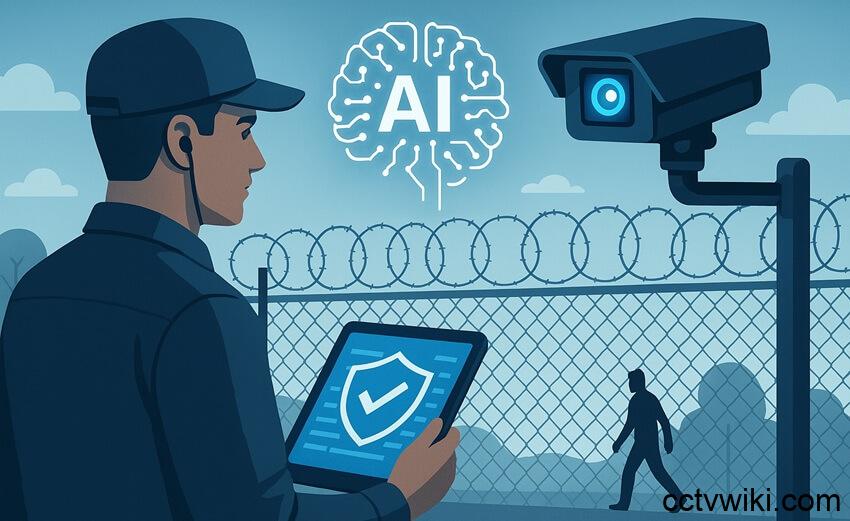AI Video Analytics: The Unsung Hero of Perimeter Security
In the world of security, the perimeter is the first line of defense, and AI video analytics is proving to be an invaluable asset in safeguarding it. While buzz surrounds large-scale AI models, the practical applications of AI in threat detection and behavioral analysis are already making a significant impact on perimeter security.
Perimeter security is all about protecting an organization’s outer boundary, and AI-powered video analytics offers a range of capabilities:
Intrusion Detection and Object Analysis
AI excels at identifying unauthorized entries and analyzing objects, which are crucial for maintaining perimeter integrity. “AI-driven intrusion detection helps operators spot attempted breaches, while AI analytics software identifies both subtle anomalies and active threats. Object detection further warns operators of aggressive weapons associated with criminal activity,” says Todd Dunning, Director of Product Management, Video Security and Analytics at Pelco.
Behavioral Analysis
AI can also detect unusual behaviors that may indicate a potential perimeter breach. “Cameras with AI video analytics can identify actions consistent with break-ins, as well as signs of loitering and suspicious movement that could suggest a planned perimeter breach,” Dunning adds.
Vehicle Gate Misuse
Vehicles can also pose a threat to the perimeter. According to Mats Thulin, Director of AI and Analytics Solutions at Axis Communications, AI can help by “identifying vehicle tailgating, forced entry, or wrong-way approaches, along with license plate recognition for automating entry and exit for authorized vehicles.”
These capabilities are enabled by a range of AI technologies, including computer vision, license plate recognition, facial recognition, and object recognition/behavioral analysis.
“Today’s core technologies include advanced enhanced imaging – such as denoising, HDR, low-light optimization, and image stabilization – along with AI-driven object detection and classification for reliable detection of people, vehicles, and animals. Audio analytics can also play a key role by identifying sounds like glass breaking or screams,” Thulin explains. “Together, these technologies provide operators with a fuller, more comprehensive and dependable view of the perimeter.”
Large-Scale AI Models: Are They Ready for Prime Time?
While large-scale AI models have generated excitement in the security industry, their effectiveness in perimeter security is still under debate. These models are touted for their ability to detect targets at longer distances, recognize objects in smaller pixels, and identify a wider range of animal species. However, challenges and limitations remain.
“Large models require intense cloud processing, introducing 15-20 second delays minimum. In security scenarios where attackers move in milliseconds, this delay is operationally useless,” says Albert Stepanyan, President and CEO of Scylla AI.
He adds, “Large AI models are architected for single-frame analysis, not continuous video streams. They miss critical temporal patterns – a person climbing a fence over 3-4 seconds appears as disconnected static images. This fundamental design flaw creates massive false negative rates where genuine threats go undetected.”
According to Dunning, both large-scale AI models and conventional convolutional neural networks (CNNs) have their strengths and weaknesses, and the choice depends on the specific application.
“CNNs provide a more reliable and resource-efficient solution for typical installations where operators know which types of threats they face and are confident in their abilities to adjust to meet unique, pre-specified needs. Large-scale models are best-suited for high-risk, well-funded sites that often face unknown risks and have access to vast resources,” he says.
Thulin suggests that a hybrid approach may be the most effective solution.
“Large-scale, general-purpose models may impress in demos, but perimeter security demands real-time performance in outdoor, edge environments where speed, predictability, and power efficiency are critical. Today, compact, purpose-trained models tuned for specific tasks and environments are the most effective and lead to less false alarms. Also, many of the larger models are difficult to run on edge devices requiring server or cloud processing and in the latter case this also creates a dependency on cloud connectivity,” he says. “Long term, a hybrid approach is ideal: leveraging larger models in the cloud for second level processing, while deploying efficient analytics at the edge for live detection in the perimeter use case.”

